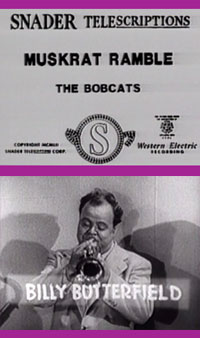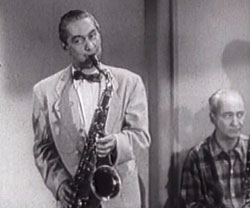 The Bobcats were also known as Bob Crosby & the Bobcats. Their name gets rendered variously Bobcats, Bob-cats, and Bob Cats, but most commonly as a single word. The Bobcats were also known as Bob Crosby & the Bobcats. Their name gets rendered variously Bobcats, Bob-cats, and Bob Cats, but most commonly as a single word.
When they spun out of the Bob Crosby Orchestra as a separate act, Crosby was no longer in their midst. This is kind of too bad, as none of the Bobcats were vocalists, & material that was great with the whole Orchestra & Bob Crosby providing a vocal bridge, gets streamlined into simplified instrumentals when the Bobcats worked on their own.
The Bobcats provided the stable core of Crosby's orchestra from 1935 through 1942. Though the band split up around this time, there were so many reunions & new bands but together by Crosby that one way or another they were around for decades after the alleged break-up. In 1950 the Bobcats made a studied effort to establish themselves anew as an independent act, but could only be nostalgic in a decade of rhythm & blues was bringing forth rock 'n' roll.
Dixieland had always been a significant but never exclusive part of the Crosby orchestra agenda, as the orchestra was a well-rounded swing band. But for the small spin-off, dixieland became dominant. This is only good for die-hard fans of a single strain of ragtime.
"True" ragtime from the 1890s through 1920s was never so narrow in sound as specialist Dixieland Bands started to make of it in the 1930s & 1940s. It is this later "predictable" strain that survives down to the present day & causes so much revival jazz of the Dixieland flavor to seem suitable only for vintage cartoons.
The Bobcats consisted of great musicians, of that there's no doubt, but an awful lot of their stuff is repetitious commercial ragtime that has all the currency of barbershop. Fortunately some of their material breaks from this predictable strain & their greater capacity for innovation shine through occasionally.
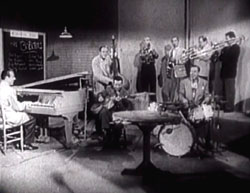 A chalk board announces, in a sloppy hand, a rehearsal by the Bobcats, & names them: Bob Haggart, Ray Bauduc, Billy Butterfield, Matty Mattlock, Eddie Miller, Jess Stacy, Nappy Lamare & Warren Smith. A chalk board announces, in a sloppy hand, a rehearsal by the Bobcats, & names them: Bob Haggart, Ray Bauduc, Billy Butterfield, Matty Mattlock, Eddie Miller, Jess Stacy, Nappy Lamare & Warren Smith.
Behind the title card, we already hear a ragtime tune in progress. It's Muskrat Ramble (1952), & momentarily we're see the band arrayed around the room. The number never had lyrics until Country Joe & the Fish recorded "Feel Like I'm Gonna Die Rag."
The stage is arranged to give the general impression of a cafe, but without customers, probably too early in the day since it's rehearsal time.
This same setting, with the same chalkboard usually visible, is used for all the Bobcats' Snader telescriptions, as they were all filmed in a single day on a single set. Snader telescriptions are three minutes or less, made for television airplay either as filler or for disc jockeys on early television requiring visuals with the discs they jocked.
There's a big white piano, the same as seen in many other Snader telescriptions used by any number of pianists. The camera then shows the band members one by one, reinforcing from the chalkboard who they are, with their names appearing on the screen in what appears to be chalk. This kind of focused individual credit was something that was almost never done in telescriptions.
We're shown in turn double-bassist Bob Haggart, guitarist Nappy Lamare, drummer Ray Bauduc who has a couple fancy moves on the kit, pianist Jess Stacy smiling to beat the band as he tickles the keys, Kentucky clarinetest Matty Matlock, tenor saxophonist Eddie Miller, Billy Butterfield on trumpet, & Warren Smith on trumbone.
Each member gets a solo as introduced with their names appearing like subtitles but in chalk. So by the time they're all named, we're halfway through the number.
It's a good arrangement for the sake of introductions, with the solos better sounding than when the whole band works together. Compared to Nobel Sissel, Kid Ory or Louis Armstrong, the Bobcats are merely Disnified imitations of the real deal.
As soloists each member of the Bobcats comes off swell. But their "all together now" approach to ragtime is pretty much commercial-generic & indistinguishable from the Firehouse Five or any number of ragtime bands then & today, especially after 1950.
Fortunately the Bobcats weren't restricted to this sound, but throughout their telescriptions it'll be what dominates, thus only two or three among all these reviewed are remarkable.
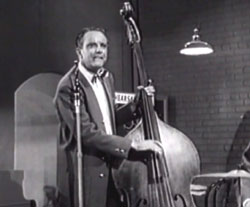 The original Snader telescriptions title card for Big Noise from Winnetka (1951) gives special credit to Bobby Haggart & Ray Bauduc, as the other bandmates are entirely excluded from this little film.
The original Snader telescriptions title card for Big Noise from Winnetka (1951) gives special credit to Bobby Haggart & Ray Bauduc, as the other bandmates are entirely excluded from this little film.
Ray was a fabulous drummer all round. When the Crosby orchestra disbanded the first time, he was in great demand & worked with Jimmy Dorsey & Jack Teagarden. He also organized small bands of his own to prove his chops at bebop.
To a slight extent it's tragic to see him brought back again & again to a nostalgia act when he was in fact the equal of Baby Dodd or Gene Krupa or any great jazz drummer you might name.
But for Big Noise in Winnetka there's nothing the least tragic. This is in fact spectacular. It starts off with Ray's very appealing drum solo. Bassist Bobby H. joins in, & whistles the tune while he's slaps that bass. This whistling is unique & wonderful, & hearing it just once is probably enough to get you whistling it yourself.
It continues with just these two guys making a remarkably cool musical racket that's nearly experimental. Ray's second drum solo is absolutely amazing, & he even drums on Bobby's bass strings as Bobby fingers the neck. It's amusing to watch, but it's also a tremendously fine number. It was destined to be covered by lots of bands, but it was written by bassist Bob Haggart, & first recorded by the Bob Crosby Orchestra in 1938..
Bauduc & Haggart can also be seen doing this number in Reveille With Bevery (1943), but with the entirety of the Bob Crosby Orchestra chiming in for a much more elaborate arrangement. Crosby sings the wonderful lyrics, assisted by a harmony group of two guys & two gals (the gals are identical twins Lee & Lynn Wilcox). They also performed the number in Let's Make Music (1941).
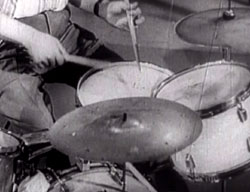 Ray the drummer starts out March of the Bobcats (1951) with a marching-drum beat on snares.
Ray the drummer starts out March of the Bobcats (1951) with a marching-drum beat on snares.
Then the whole band joins in with a fairly standard ragtime performance founded on New Olreans street march instrumentals.
Once again there are solos for each player that have their names in chalk appear low on the screen as each bandmate takes his turn. By the time they've named everyone with a solo, it's almost over.
This is so basic & cornpone a piece of dixieland jazz that it moves me not one whit. The composition remains popular with cornpone dixieland bands right up to today, however, so clearly it has its fans.
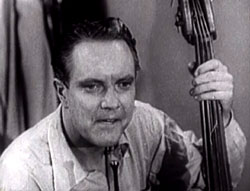 Once again bassist Bob Haggart whistles, this time for a bluesy introduction to Savoy Blues (1951). It's not as thrilling as Big Noise in Winnetka but still Bobby's one hip whistler.
Once again bassist Bob Haggart whistles, this time for a bluesy introduction to Savoy Blues (1951). It's not as thrilling as Big Noise in Winnetka but still Bobby's one hip whistler.
When the whole band chimes in, it has a "sleepy time down home" quality more than anything of sorrowful blues, fused with a calculatedly out-of-sync slow-ragtime sentimentality.
It's a delightful number. Besides the whistling solo, there's also a great sax moment for the ever-admirable Eddie Miller.
The arrangement shows up the problem with the "sample of each band mate" arrangements of to many of their telescribed numbers.
It would've been spiffier if each song highlighted a different musician as soloist, rather than crowding solos for everyone in almost everything. Oddly enough "Savoy Blues" was often arranged by other bands to provide just the series of solos the Bobcats liked to share, but thank god they didn't do that yet again.
Kid Ory's 1920s composition "Savoy Blues" came to be the veritable themesong for the Savoy Ballroom in Harlem, which opened its doors in 1926 & was a cultural mecca until it closed in 1958.
But curiously enough, it was actually written for the Savoy Ballroom in Chicago which opened in 1927. Kid Ory & Louis Armstrong played the number together, in both Savoy Ballrooms, Chicago & Harlem, but they first sang it in the Chicago Savoy late in '27.
If you've heard the first recording by Louis Armstrong & His Hot Five (including Ory on trumbone, Johnny Dodds dominating on clarinet, Lil Hardin Armstrong on piano, Lonnie Johnson on guitar, & Johnny St. Cyr on banjo) then you'll know why it's hard to be moved by the Bobcats' bland try.
Red Allen's "Savoy Strut," Louis Armstrong's "Stompin' at the Savoy," & Johnny Hodges & Duke Ellington's "Savoy Shout" all specifically celebrated the Harlem Savoy.
The gangster-owned Savoy was kind of an equivalent of the Cotton Club except the Cotton Club did not serve black people, & the dancers on the floor were way better at the Savoy (the dancers on the stage at the Cotton Club were from the Savoy). Kid Ory also wrote "Muskrat Ramble" in 1923, which the Bobcats covered in the telescription series.
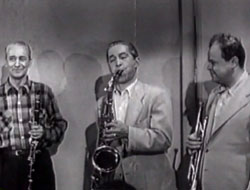 The Bobcats do a ragtime arrangement of Who's Sorry Now (1951), once again, as in all their telescriptions, staged in their rehearsal cafe.
The Bobcats do a ragtime arrangement of Who's Sorry Now (1951), once again, as in all their telescriptions, staged in their rehearsal cafe.
The best known version of this song is undoubtedly that of Connie Francis in 1958. But it was written in 1923, lyrics by Bert Kalmar & Harry Ruby, music by Ted Snyder, the latter also well remembered for "Shiek of Araby."
Kalmar & Ruby's best known songs were Helen Kane's 1928 big hit "I Wanna Be Loved by You" & an oftenp-covered standard "Three Little Words" published in 1930. In the movie Three Little Words (1950), Red Skelton played Harry Ruby, & Fred Astaire played Bert Kalmar.
The Bobcats don't interpret lyrics so just tackle Ted Snyder's tune. Yet again their names appear on the screen one by by one as they each take fine if awfully short solos.
This is the least generic of their ragtime arrangements but essentially the three telescriptions which have their names subtitled are so similar that they can be tedious listened to all at once.
I can love post-ragtime-era syrupy dixieland bands like the Bobcats or the Firehouse Five one song at a time, but their variety is not great enough to listen to lots of it song after song.
Who's Sorry Now has the slight bonus of being able to think the lyrics as it goes along, besides Ray Baubac's tremendous drumwork throughout.
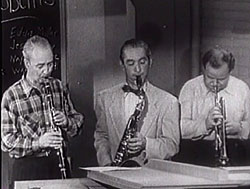 There seems to be a gag built into the opening for Complainin' (1951) in that the reeds squeal hideously with complaint, over an almost bluesy beat. Musically these squealy moments are not pleasant.
There seems to be a gag built into the opening for Complainin' (1951) in that the reeds squeal hideously with complaint, over an almost bluesy beat. Musically these squealy moments are not pleasant.
But then in settles down into a melodic number, & Complainin' isn't just another generic ragtime piece that dominated the Bobcats' performances whenever the lacked the full back-up of Bob Crosby & His Orchestra.
It has some moody movements, with fine piano work from Jess Stacy who really owns the best parts of the performance. But with the overall arrangement, the mood shifts so often it's hard to get a handle on the intent.
Everyone seems to have had their own arrangement. It's like a "sampler" of a movie soundtrack, here's the sad bit for a scene of tragedy, a jesting bit for the comedy relief sequence, the piano bar routine introducing the detective hero, & the action bit for the climax. It just doesn't hold together as a sensible arrangement.
 Saxophonist Eddie Miller sustains an instrumental version of Love's Got Me in a Lazy Mood (1951) with a lazy-blues riff that can induce a sigh. Ray Baubec is laying on some sweet soft brushes to his drums.
Saxophonist Eddie Miller sustains an instrumental version of Love's Got Me in a Lazy Mood (1951) with a lazy-blues riff that can induce a sigh. Ray Baubec is laying on some sweet soft brushes to his drums.
This song was written by Eddy Miller & Johnny Mercer. It has lyrics, left off this instrumental version.
With its lyrics intact, it became a standard covered by many bands during the 1940s, including Frankie Carle & His Orchestra, the Lawson-Haggart Jazz Band, Paul Weston's Orchestra with Johnny Mercer, among others, including even Jimmy Dorsey & His Orchestra.
Eddie's sax gets a breather when Billy Butterfield's trumpet takes over, his head tucked down as always, like a shy & slightly rotund old gent. Then it's back to the smooth sax.
The band is really together on this one, & I vastly prefer their bluesy moments to their excessively jolly ragtime numbers.
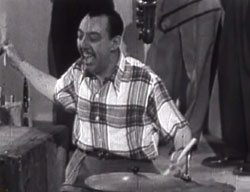 Though the title promises blues, Panama Blues (1951) bursts forth with ragtime upbeat joy (for which reason it's real title was just "Panama").
Though the title promises blues, Panama Blues (1951) bursts forth with ragtime upbeat joy (for which reason it's real title was just "Panama").
This arrangement is a little less generic than their other dixieland telescriptions. For a while Ray drums on the rims for a clickity-clickity beat, then high-hats through Jess Stacy's piano riff.
There was indeed a big jazz movement in Panama, which this number celebrates. It had been a standard of southern jazz since late in the Roaring Twenties, but had not been the sort of number to become a chart hit.
Jess's piano solo is followed by Billy Butterfield wailing on a trumpet, then Eddy Miller on sax, & so on from musician to musician.
The Bobcats did this "everyone gets a solo!" routine over & over again, until it sometimes seems they're only ever doing an opening number to introduce themselves, & just can't get on with the act. But for once with Panama Blues it melds pretty nicely & isn't too obvious.
By the end, Ray Bauduc's tossing his arms over the drums like a crazed bat, his mouth wide open with happiness. The pleasure is infectious.
The Bobcats telescriptions can be had on Dixieland Jazz Volume I (1985) together with Jack Teagarden's much more exciting Snaders; & on Swing Era: Geroge Shearing (2003) together with more thrilling filmed perfromances from Shearing, Tony Pastor, Slim Gaillard Trio, Mel Torme, & others.
copyright © by Paghat the Ratgirl
|
